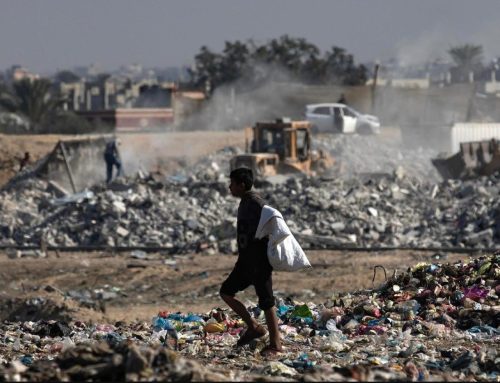As you arrive from Jerusalem, the first street of Bethlehem, lined with old, carved limestone houses, is deserted. Where the tourists used to throng, the restaurants are boarded up. In a few months, a high concrete wall will run down the middle of this street, blocking a neighbourhood of Bethlehem from the rest of the city.
As you arrive from Jerusalem, the first street of Bethlehem, lined with old, carved limestone houses, is deserted. Where the tourists used to throng, the restaurants are boarded up. In a few months, a high concrete wall will run down the middle of this street, blocking a neighbourhood of Bethlehem from the rest of the city.
The inhabitants here, predominantly from Bethlehem’s fast-dwindling Palestinian Christian community, will be cut off from their city by a concrete wall guarded by Israeli army patrols. They will be allowed to cross into Bethlehem only through an Israeli army checkpoint, with permits the army can issue or withhold as it sees fit. They will not be allowed into Jerusalem, on the other side of the pocket of land they will be walled off in.
Amjad Awwad will be cut off from the mini-market he runs. His house is on one side of the street, the mini-market on the other. After the wall is built he will need the Israeli army’s permission to go to work and to go home again. But that is not his only worry.
“They told us if you want a doctor in the night the hospital will have to phone the Israeli government and arrange permission for him to be allowed in. If it’s a heart attack, we’ll die before they allow the ambulance in.”
After the wall is built, the Bethlehem municipality will even need military permission to send trucks to collect the rubbish. The wall is part of what has become known as Israel’s “Berlin Wall”, electrified fences and concrete walls the Israeli government is building around the West Bank to seal it off and stop Palestinian militants crossing into Israel.
Here, as elsewhere, the wall is not following the 1967 border but dipping deep into the West Bank. The reason it is slicing into Bethlehem, say Israeli authorities, is so Rachel’s Tomb, a Jewish pilgrimage site inside the city, will be on the Israeli side of the wall, guaranteeing easy access for pilgrims.
For the 500 or so people who will be cut off from the rest of Bethlehem, the wall is a disaster. The order to build it was announced this week, while the world’s attention was on Iraq. The Israeli cabinet decision to include Rachel’s Tomb was made public on 11 September, the anniversary terrorist attacks on America.
No coincidence, says the Mayor of Bethlehem, Hanna Nasser, who will be cut off from his relatives by the wall. His son-in-law lives in the area that will be walled off.
“Why do they need the wall?” he asks. “That whole area around Rachel’s Tomb is already under full Israeli control under the Oslo Accords.”
The tomb is already surrounded by a concrete wall, and there are Israeli army guard-posts on top of the buildings around it.
“Why do they need it unless they have hidden intentions?” says Mr. Nasser, suggesting the real reason for walling off the area is to force the people to leave, so the land can be annexed to Israel.
That sentiment is echoed by Dr Jad Issac, of the Applied Research Institute, Jerusalem, a Palestinian organization that makes maps of Israeli settlement-building in the occupied territories using satellite images it buys commercially. They show Bethlehem being surrounded by fences to protect new settlement suburbs of Jerusalem built in the occupied West Bank.
“There will be no room for Bethlehem to expand naturally,” Dr Issac says. “The population density will become so high people will start leaving freely. We will be forced to migrate.”





